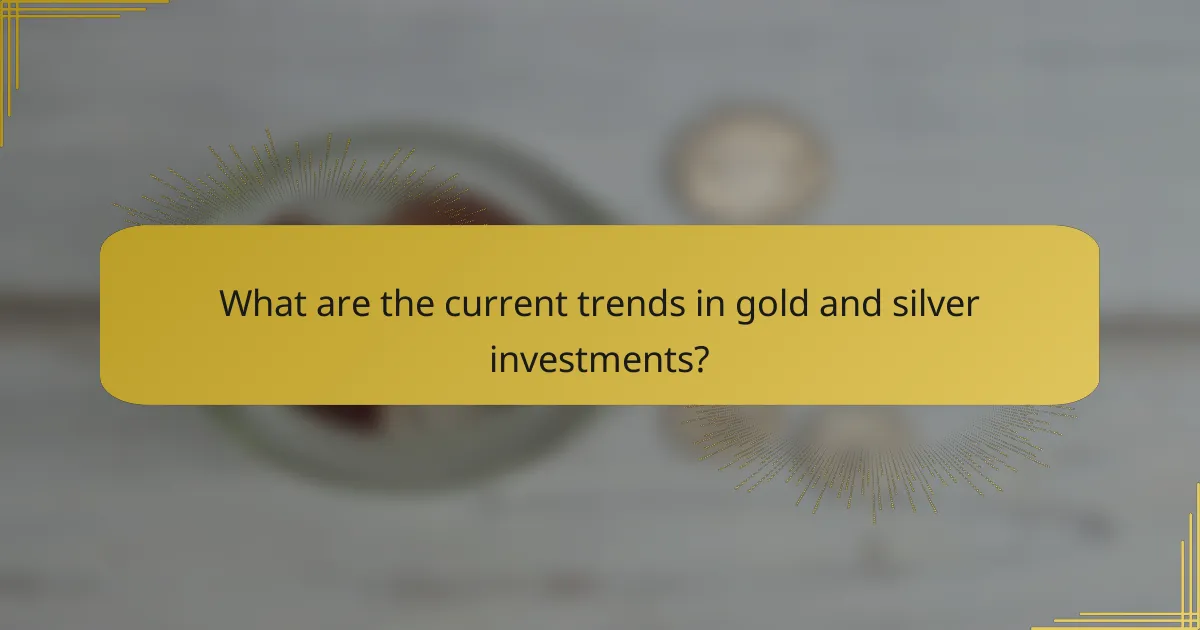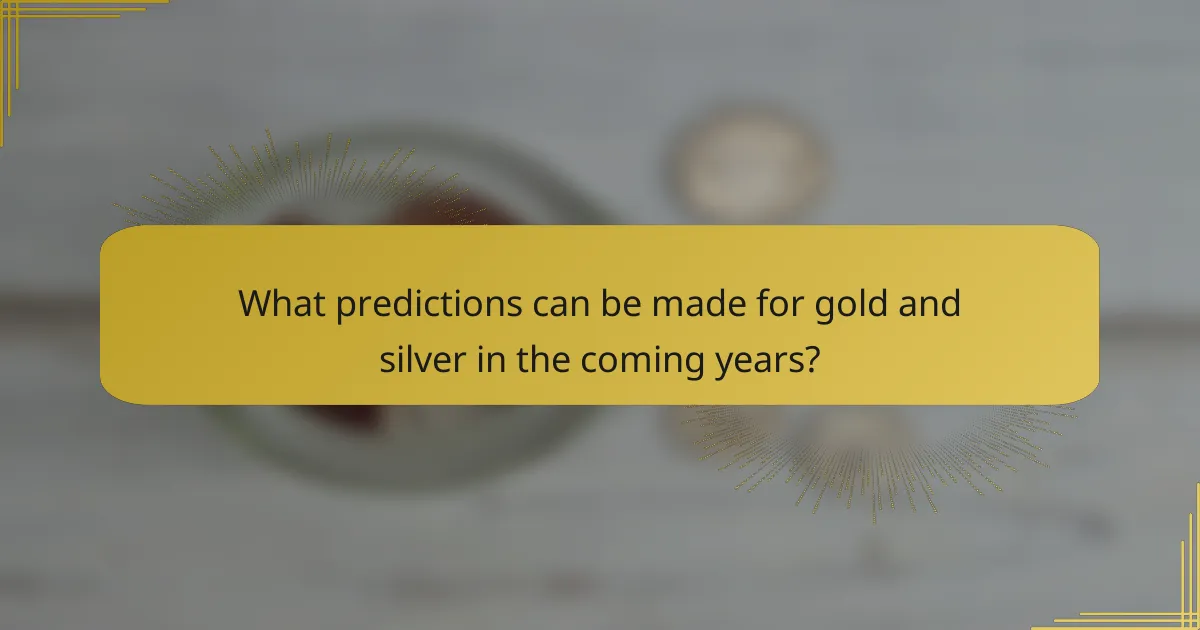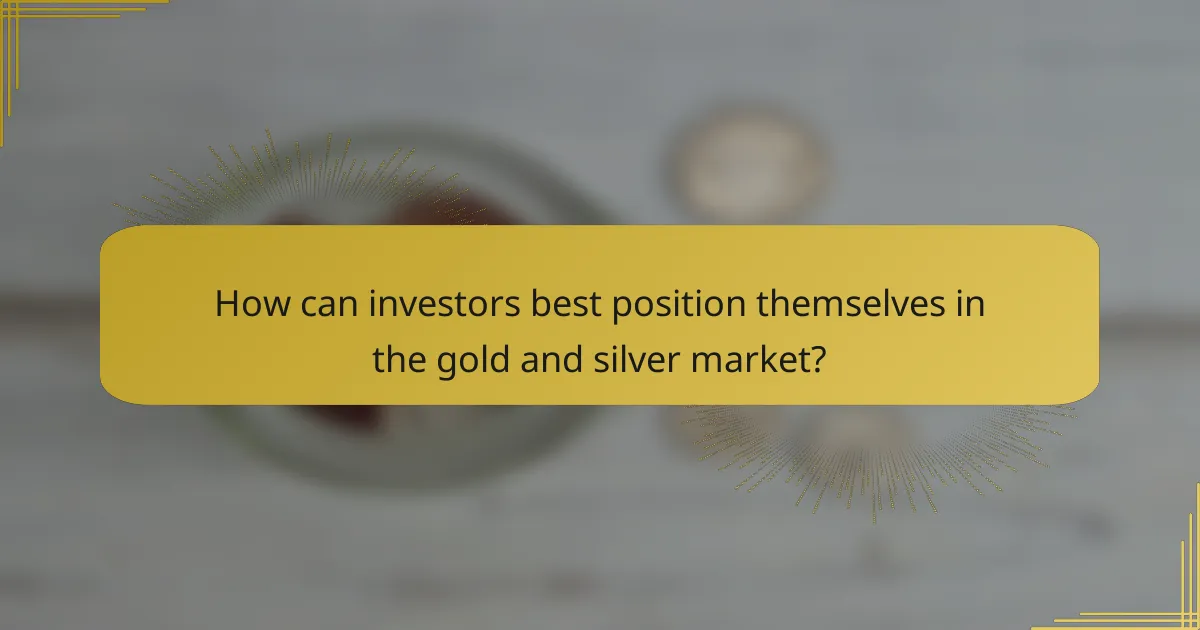Gold and silver are increasingly recognized as safe-haven assets amid economic uncertainty, with investors diversifying their portfolios to include these precious metals. In 2023, gold prices surpassed $2,000 per ounce, highlighting its role as a hedge against inflation, while silver has gained traction due to its industrial applications, particularly in technology and renewable energy. Analysts anticipate continued price growth for both metals, driven by inflation concerns, market volatility, and rising demand for silver in solar panels. Central banks are also adding gold to their reserves, further supporting its value. This article explores current trends, predictions, and strategies for investing in gold and silver, emphasizing the importance of diversification and market awareness.

What are the current trends in gold and silver investments?
Current trends in gold and silver investments indicate a growing interest in safe-haven assets. Investors are increasingly turning to these metals amid economic uncertainty. Gold prices have shown resilience, often rising during market volatility. Silver is gaining attention due to its industrial demand, especially in technology and renewable energy sectors.
In 2023, gold reached highs of over $2,000 per ounce, reflecting its status as a hedge against inflation. Meanwhile, silver prices have also risen, driven by supply constraints and increased use in solar panels. Central banks are adding gold to their reserves, further supporting its value.
Investors are diversifying portfolios by including both gold and silver. This strategy aims to mitigate risks associated with traditional assets. Overall, the trend emphasizes a shift towards tangible assets in uncertain economic climates.
How do economic factors influence gold and silver prices?
Economic factors significantly influence gold and silver prices. Inflation rates directly affect the purchasing power of currency. When inflation rises, investors often turn to gold and silver as safe-haven assets. This increased demand can drive up prices. Conversely, when inflation is low, demand for these metals may decrease, leading to lower prices.
Interest rates also play a crucial role. When interest rates are high, the opportunity cost of holding non-yielding assets like gold and silver increases. This can result in a decline in prices. On the other hand, lower interest rates make precious metals more attractive, often boosting their prices.
Economic stability influences investor sentiment. In times of economic uncertainty, gold and silver are seen as protective investments. Historical data shows that during financial crises, such as the 2008 recession, gold prices surged as investors sought safety.
Currency strength affects precious metal prices as well. A weaker dollar typically leads to higher gold and silver prices. This is because these metals are priced in dollars; a weaker dollar makes them cheaper for foreign investors.
Overall, economic factors such as inflation, interest rates, economic stability, and currency strength are key determinants of gold and silver prices.
What role does inflation play in the value of gold and silver?
Inflation generally increases the value of gold and silver. As inflation rises, the purchasing power of currency decreases. Investors often turn to precious metals as a hedge against inflation. This increased demand drives up the prices of gold and silver. Historical data shows that during periods of high inflation, gold has often reached record highs. For example, in the late 1970s, gold prices surged due to significant inflation rates. Similarly, silver tends to follow gold’s price movements during inflationary periods. Thus, inflation plays a crucial role in influencing the value of these metals.
How do geopolitical events affect market stability for these metals?
Geopolitical events significantly impact market stability for gold and silver. These metals are often viewed as safe-haven assets during times of uncertainty. For example, conflicts or tensions can lead to increased demand for gold and silver as investors seek to preserve wealth. Historical data shows that during the 2008 financial crisis, gold prices surged by over 25%. Additionally, geopolitical instability in regions like the Middle East often results in price volatility for these metals. Market reactions to such events can lead to rapid fluctuations in value. Investors typically respond to news of geopolitical tensions by reallocating portfolios towards precious metals. This behavior creates a direct correlation between geopolitical events and market stability for gold and silver.
What are the historical performance patterns of gold and silver?
Gold and silver have historically exhibited distinct performance patterns. Gold typically acts as a safe-haven asset during economic uncertainty. For example, during the 2008 financial crisis, gold prices surged, reaching over $1,000 per ounce. Silver, while also a precious metal, is more volatile and often follows industrial demand trends. In 1980, silver reached an all-time high of around $50 per ounce, driven by speculative trading. Over the last two decades, gold has generally outperformed silver, especially during periods of high inflation or geopolitical tensions. From 2000 to 2020, gold prices increased by approximately 500%, while silver rose about 300%. These patterns indicate that gold is often favored in times of crisis, whereas silver’s performance can be influenced by broader economic factors.
How have gold and silver prices fluctuated over the last decade?
Gold and silver prices have experienced significant fluctuations over the last decade. In 2013, gold prices peaked at around $1,900 per ounce before declining to approximately $1,050 by late 2015. Since then, gold prices have steadily increased, reaching over $2,000 per ounce in August 2020 due to economic uncertainty caused by the COVID-19 pandemic. In contrast, silver prices have also shown volatility, starting at around $30 per ounce in 2011, dropping to about $14 in 2015, and then rising to nearly $30 again in 2020. Both metals have been influenced by factors such as inflation, interest rates, and geopolitical tensions, contributing to their price variations.
What lessons can investors learn from past market behaviors?
Investors can learn several key lessons from past market behaviors. Historical market trends often reveal patterns of volatility and recovery. For example, during the 2008 financial crisis, gold prices surged as investors sought safe-haven assets. This illustrates the importance of diversification in investment portfolios. Additionally, past market behaviors show that timing the market can be risky. Many investors who tried to sell at market peaks often missed subsequent gains. Data from the S&P 500 indicates that missing just a few of the best trading days can significantly reduce overall returns. Furthermore, investor sentiment can heavily influence market movements. The dot-com bubble of the late 1990s serves as a reminder of how irrational exuberance can lead to unsustainable valuations. Recognizing these patterns can help investors make informed decisions in future market conditions.

What predictions can be made for gold and silver in the coming years?
Gold and silver prices are expected to rise in the coming years. Analysts predict that economic uncertainty will drive investors towards these precious metals. Inflation concerns and potential market volatility contribute to this trend. Historical data shows that gold often performs well during economic downturns. Silver is also anticipated to benefit from industrial demand growth. The transition to renewable energy may increase silver usage in solar panels. Additionally, central banks are likely to continue accumulating gold as a reserve asset. Overall, both metals are positioned for upward price movements based on current economic indicators.
What expert forecasts are available for gold and silver prices?
Expert forecasts for gold and silver prices include insights from various financial analysts and institutions. Analysts from Goldman Sachs predict gold prices may reach $2,300 per ounce in the next 12 months. Meanwhile, a report by the World Gold Council highlights that silver prices could rise due to increased industrial demand. Additionally, Bank of America forecasts silver may hit $30 per ounce by 2025. These predictions are based on market trends, inflation rates, and geopolitical factors influencing precious metals.
How do analysts predict the impact of global economic recovery on these metals?
Analysts predict the impact of global economic recovery on metals like gold and silver through various economic indicators. They monitor GDP growth rates, industrial demand, and inflation trends. For instance, increased industrial activity typically raises the demand for silver in electronics and manufacturing. Conversely, gold often serves as a safe haven during economic uncertainty. Analysts also assess central bank policies and interest rates, as lower rates can boost gold prices. Historical data shows that during past recoveries, both metals often experienced price increases due to heightened investment and consumer confidence.
What technological advancements could influence gold and silver mining?
Technological advancements that could influence gold and silver mining include automation, artificial intelligence, and improved extraction methods. Automation can enhance efficiency and reduce labor costs in mining operations. For instance, autonomous trucks and drilling systems are already being implemented in some mines. Artificial intelligence can optimize resource allocation and predictive maintenance, which improves operational efficiency. Additionally, advancements in extraction methods, such as bioleaching, can increase recovery rates of gold and silver from low-grade ores. According to a report by the World Gold Council, these technologies can significantly lower production costs and environmental impacts.
What potential risks should investors be aware of?
Investors should be aware of several potential risks when investing in gold and silver. Market volatility is a significant risk, as prices can fluctuate widely due to economic conditions. For example, gold prices dropped by 28% from 2011 to 2015, reflecting this volatility. Additionally, currency fluctuations can impact the value of precious metals, particularly against the US dollar. Geopolitical instability also poses a risk, as conflicts can either drive prices up or create uncertainty in the market.
Supply chain disruptions can affect availability and pricing. For instance, mining strikes or natural disasters can halt production. Regulatory changes can also pose risks, as new taxes or restrictions may impact profitability. Finally, liquidity risk exists; during market downturns, selling assets may be challenging without significant losses. Understanding these risks helps investors make informed decisions.
How might changes in government policies affect precious metals?
Changes in government policies can significantly affect precious metals. For example, alterations in taxation can influence investment demand. Higher taxes on capital gains may deter investors from purchasing gold and silver. Conversely, tax incentives can stimulate demand for these metals. Regulatory changes, such as import/export restrictions, can also impact availability. Increased tariffs on imported metals may raise domestic prices. Additionally, monetary policies, like interest rate adjustments, can affect the attractiveness of precious metals as an investment. Lower interest rates typically increase demand for gold as a non-yielding asset. Historical data shows that during economic uncertainty, government policy shifts often lead to increased precious metal prices. For instance, during the 2008 financial crisis, government interventions led to a surge in gold prices as investors sought safe-haven assets.
What are the implications of new market entrants for gold and silver prices?
New market entrants can significantly impact gold and silver prices. Increased competition often leads to greater supply in the market. This surge in supply can drive prices down, especially if demand does not keep pace. Conversely, if new entrants bring innovative mining or trading techniques, they may enhance market efficiency. This efficiency can lead to price stabilization. Additionally, new entrants might attract more investors to the market. Increased investment can boost demand, potentially raising prices. Historical data shows that when new players enter commodity markets, volatility often increases. This volatility can create both risks and opportunities for investors.

How can investors best position themselves in the gold and silver market?
Investors can best position themselves in the gold and silver market by diversifying their portfolios with these precious metals. Diversification reduces risk and enhances potential returns. Investors should consider allocating a specific percentage of their portfolios to gold and silver. Historical data shows that gold has maintained its value during economic downturns, often outperforming stocks. Silver, while more volatile, can offer substantial upside during market recoveries. Monitoring market trends and geopolitical events is crucial for timing purchases. Investors should stay informed about supply and demand dynamics affecting prices. Utilizing exchange-traded funds (ETFs) for gold and silver can provide liquidity and ease of trading. Regularly reviewing and adjusting positions based on market conditions will optimize investment strategies.
What strategies should investors consider for maximizing returns?
Investors should consider diversification, dollar-cost averaging, and investing in ETFs for maximizing returns. Diversification reduces risk by spreading investments across different assets. For example, combining gold and silver with stocks can balance potential losses. Dollar-cost averaging involves consistently investing a fixed amount over time. This strategy mitigates the impact of market volatility. Investing in exchange-traded funds (ETFs) allows investors to gain exposure to gold and silver without direct ownership. According to a 2021 report by the World Gold Council, gold-backed ETFs saw record inflows, indicating strong investor interest. These strategies can enhance returns while managing risks effectively.
How can diversification within precious metals enhance investment portfolios?
Diversification within precious metals can enhance investment portfolios by reducing risk and increasing potential returns. Investing in a variety of metals, such as gold, silver, platinum, and palladium, offers different benefits. Each metal reacts differently to market conditions. For example, gold is often viewed as a safe haven during economic downturns. Silver tends to have industrial demand, which can drive its price in growing economies. Platinum and palladium have unique applications in the automotive industry, particularly in catalytic converters. Historical data shows that during market volatility, precious metals often retain value better than other asset classes. By spreading investments across multiple precious metals, investors can mitigate losses in one area while benefiting from gains in another. This strategy leads to a more balanced and resilient investment portfolio.
What are the best practices for timing purchases and sales?
The best practices for timing purchases and sales involve analyzing market trends and economic indicators. Investors should monitor gold and silver prices regularly. Utilizing technical analysis can provide insights into price movements. Keeping track of geopolitical events is crucial as they can impact precious metal prices. Additionally, seasonal trends often influence demand and pricing. Historical data shows that prices may rise during economic uncertainty. Setting specific buy and sell targets can help manage investments effectively. Lastly, diversifying investments can mitigate risks associated with timing.
What resources are available for ongoing market analysis?
Resources for ongoing market analysis include financial news websites, market research reports, and analytical tools. Financial news websites like Bloomberg and Reuters provide real-time updates. Market research firms such as Statista and IBISWorld offer in-depth reports. Analytical tools like TradingView and MetaTrader allow for technical analysis of market trends. Additionally, social media platforms and forums can provide insights from industry experts. These resources help investors stay informed about market movements and trends.
How can investors leverage technology for real-time market insights?
Investors can leverage technology for real-time market insights through advanced data analytics and artificial intelligence. These technologies provide instantaneous access to market trends and price changes. Tools like algorithmic trading systems analyze vast amounts of data quickly. This allows investors to make informed decisions based on current market conditions. Real-time alerts from financial platforms notify investors of significant market movements. Additionally, mobile applications enable on-the-go monitoring of investments. According to a report by Deloitte, 63% of investors use digital tools for real-time market analysis. This demonstrates the growing reliance on technology for effective investment strategies.
What educational materials are recommended for understanding market dynamics?
Recommended educational materials for understanding market dynamics include textbooks, online courses, and research papers. Textbooks such as “Market Microstructure Theory” by Maureen O’Hara provide foundational knowledge. Online platforms like Coursera offer courses on financial markets. Research papers from journals like the Journal of Finance present empirical studies on market behavior. Additionally, government publications, such as reports from the U.S. Securities and Exchange Commission, offer insights into regulations affecting market dynamics. These resources collectively equip learners with a comprehensive understanding of how markets operate.
What tips can investors follow to navigate the gold and silver market effectively?
Investors can navigate the gold and silver market effectively by staying informed about market trends. Monitoring economic indicators like inflation rates and interest rates is crucial. These factors significantly influence precious metal prices. Diversifying investments across different asset classes can reduce risk. Investors should also consider geopolitical events that can impact gold and silver demand. Historical data shows that gold often performs well during economic downturns. Utilizing technical analysis can help identify entry and exit points. Regularly reviewing investment portfolios ensures alignment with market conditions. Engaging with market experts can provide valuable insights and strategies.
The main entity of the article is gold and silver investments. The article examines current trends in these precious metals, highlighting their appeal as safe-haven assets amid economic uncertainty and inflation concerns. It discusses the influence of economic factors, such as inflation rates and interest rates, on gold and silver prices, as well as the impact of geopolitical events and historical performance patterns. Additionally, the article provides expert forecasts for future price movements and outlines strategies for investors to effectively navigate the market, including diversification and utilizing technology for real-time insights.